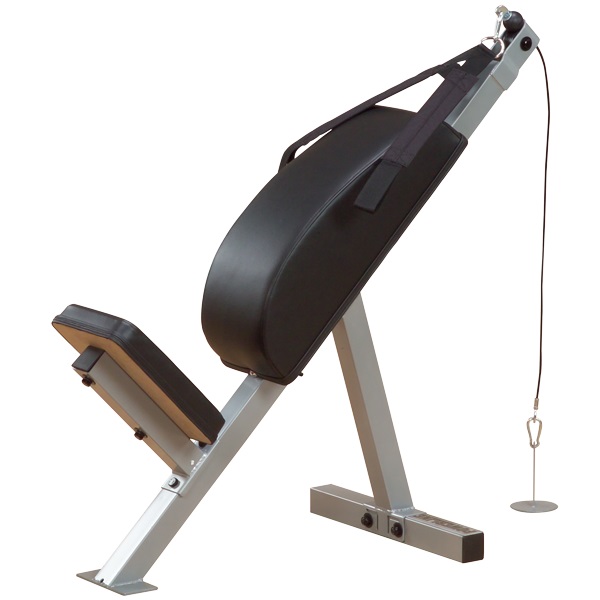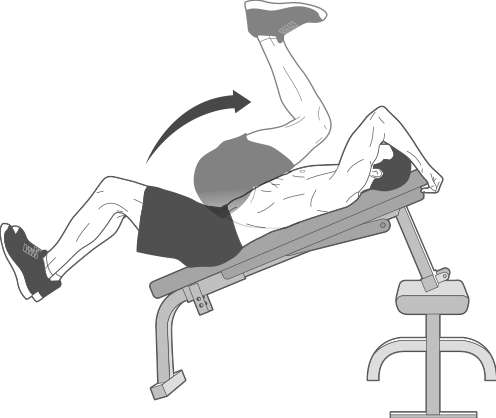10 QUESTIONS ON TRAINING WITH THE AB BENCH
by
Fred Hatfield (1995)
1) What's the key to achieving rapid abdominal development?
-- The answer to achieving that much desired washboard appearance lies in the study of the anatomy of spinal movement. The spine is made up of 33 vertebrae, only 24 of which form the flexible portion located above the sacrum. There are seven cervical vertebrae, 12 thoracic vertebrae and five lumbar vertebrae. With the exception of the first two cervical vertebrae, the extent of movement at any vertebral joint is slight, particularly in the thoracic spine, although the total movement of all joints is quite large. Within these anatomical constraints, performing crunches for abdominal development involves flexion at all of the thoracic and lumbar vertebrae.
2) Do you believe the crunch is the best abdominal exercise?
-- The crunch is good, but so are a number of other exercises. There are many variations of abdominal exercises, and there are just as many abdominal devices. All of the good ones, however, have one thing in common: In one way or another bring the ribs (the origin of the rectus abdominus), and pelvis (the insertion), closer together through spinal flexion and abdominal-muscle contraction. Your internal and external obliques aid in this movement as well.
3) What other ab exercises are good?
-- Other than the crunch, you can do reverse crunches. This exercise has the same effect as crunches; however, your knees come toward your face instead of vice versa. Some bodybuilders believe that they can get better lower-ab development with this exercise, but I personally doubt it. The research tends to refute this age-old myth. Ever see a guy with great washboard upper abs but a saggy lower abdomen? Or vice versa? There's no such thing. The abdominal wall benefits equally from crunches and reverse crunches.
-- Again, the myth is that hanging while raising your knees upward is going to selectively develop your lower abs. Actually, the hanging leg raise is the ultimate version -- the high stress version -- of reverse crunches. It's a very difficult movement to master, however, so your best bet is to do reverse crunches.
5) So you recommend crunches, reverse crunches and - for those who are strong enough and can do them correctly - hanging leg raises?
-- Yes, those are all good abdominal exercises, but the best way to train the abdominals is to first pre-stretch the muscle, then contract it against resistance. Which is exactly what the Ab Bench crunch does. This exercise allows you to stretch the rectus abdominus prior to contracting into a crunch position. Full range movements like this are generally more productive in improving strength, tone and mass. It has to do with the amount of work being accomplished on every set. Here's what happens at the cellular level.
When you stretch a muscle to its full length, the myofibrillar elements, actin and myosin, are fully stretched. That means the overlap between the actin and myosin myofibrils in minimal, and you're not capable of producing force. The cross-bridging going on between the actin and myosin strands is what causes contraction. Over a few weeks' time the actin and myosin myofibrils adapt to this new requirement of having to produce force while being stretched. They do so by growing longer in an attempt to increase the amount of overlap between them. This, of course, has the net effect of increasing the amount of force you can generate even while stretched.
6) Isn't this arching back into the stretch position dangerous?
-- Not a all. The curvature of the Ab Bench's back pad is precisely matched to the range of movement Mother Nature intended for your thoracic and lumbar spine. This ensures non-traumatic movement from an unforced hyperextended position to an unforced hyperflexed position. What's more, full-range crunches are 100% more productive than conventional on-the-floor half-range crunches because the amount of work you're accomplishing is virtually double.
7) And you believe it works the entire rectus abdominus, from rib cage to pelvis?
-- Absolutely. While electromyographic studies have demonstrated that the upper portion of the abs produces more activity when you perform crunches with no weight, when you add as little as 10 pounds the activity is equal throughout the muscle. The same studies demonstrated that reverse crunches can produce greater activity in the lower abs than in the upper abs, but they also produced activity in the obliques. The bottom line is that when resistance is applied to the crunch movement, as it is with the Ab Bench, differences in electrical activity disappear and contraction becomes relatively uniform throughout the entire rectus abdominus.
8) Do you favor high repetitions for ab training?
-- Like all other muscles in your body the rectus abdominus responds best to progressive resistance. You must train your abs as you do the rest of your muscles, but don't think that adding weight is going to give you a heavy waistline. The abdominal wall is a sheet of muscle, unlike, say, your biceps. Your rectus abdominus isn't prone to bulge like a biceps. People with large waistlines tend to have either a large pelvic girdle, a beer belly, lots of fat or a combination of the three.
9) So if the rectus abdominus is a sheetlike muscle, the segments we see aren't individual muscles?
-- Correct. I read somewhere that each segment moves or rotates a small part of the spinal column about a point known as a pivot point. According to this source, there are four pivot points, relating to the visible segments, along the spine, and as the ab muscles contract, the pivot point moves down. This is definitely wrong! While the lumbar vertebrae have a greater range of motion than the thoracic, it's a function of the anatomical structure of the spine and not the result of a small portion of the abs contracting. In fact, each of the movable vertebrae in the thoracic and lumbar spine is a pivot point, and there are many more than four.
10) So the best way to train abs is . . .
-- If you don't have an Ab Bench, use crunches and reverse crunches -- and try to get your hands on an Ab Bench as soon as you can. It's simply the best device for abdominal training on the market today.
Ab Mat with Anti-Slip Tailbone Protection









No comments:
Post a Comment